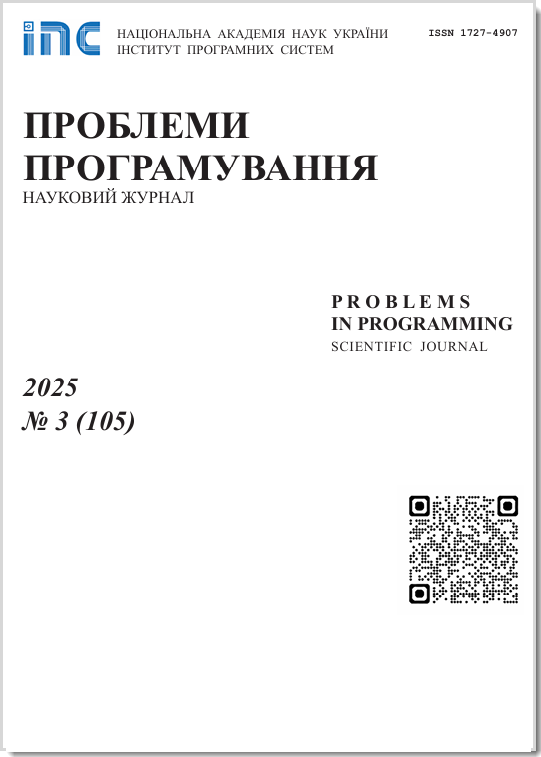Analytical review of the state of research on modeling the processes of pursuit/escape in three-dimensional space
Abstract
The article provides an analytical review of the main trends dominant in the world in solving the problems of modeling the processes of pursuit/escape in three-dimensional space. In order to obtain a more structured consideration of the current state, the main aspects of the research performed are identified and further analysis of such aspects is carried out. The main approaches to modeling the process of pursuit/escape in three dimensional space and the objects that are considered are analyzed. The methods of planning the paths of participants in the process of pursuit/escape in three-dimensional space are studied. The approaches used to form pursue/escape strategies in three-dimensional space are considered. Based on the results of the analysis, it is substantiated that the review allows to get a general idea of the main global trends that have developed today in the study of the processes of pursuit/escape in three-dimensional space.
Prombles in programming 2025; 1: 3-12
Keywords
Full Text:
PDF (Українська)References
Isaaks R. (1967) Differential games. Мir. 479 p. (in Russian)
Krasovsky N.N., Subbotin A.I. (1974) Positional differential games. Nauka. 456 p. (in Russian)
Petrosyan L.A., Riskhiev B.B. (1991) Pursuit on the plane. Nauka. 91 p. (in Russian)
Petrosyan L.A., Tomsky G.V. (1983) Geometry of simple pursuit. Nauka. 140 p. (in Russian)
Pshenichny B.N., Ostapenko V.V. (1992) Differential games. Naukova dumka. 259 p. (in Russian)
Chikriy A.A. (1992) Conflict-controlled processes. Naukova dumka. 364 p. (in Russian)
Weintraub I.E., Pachter M., García E. (2020) An introduction to pursuit-evasion differential games. 2020 American Control Conference (ACC), pp. 1049-1066. CrossRef
Yalovets A.L. (2019) Multi-agent modeling of pursuit on the plane: from theory to software implementation. Naukova dumka. 165 p. (in Ukrainian)
Lopez V.G., Lewis F.L., Wan Y., Sanchez E.N., Fan L. (2020) Solutions for multiagent pursuit evasion games on communication graphs: finitetime capture and asymptotic behaviors. IEEE Transactions on Automatic Control. Vol. 65, No. 5, pp. 1911-1923.
https://doi.org/10.1109/TAC.2019.2926554">CrossRef
Deng Z., Kong Z. (2020) Multi-agent cooperative pursuit-defense strategy against one single attacker. IEEE Robotics and Automation Letters. Vol. 5, No. 4, pp. 5772-5778. CrossRef
Liang X., Zhou B., Jiang L., Meng G., Xiu Y. (2023) Collaborative pursuit-evasion game of multi-UAVs based on Apollonius circle in the environment with obstacle. Connection Science. Vol. 35, Iss.1, pp. 1-24. CrossRef
Paczolay G., Harmati I. (2021) A simplified pursuit-evasion game with reinforcement learning. Periodica Polytechnica Electrical Engineering and Computer Science. Vol. 65, No. 2, pp. 160-166. CrossRef
de Souza C., Newbury R., Cosgun A., Castillo P., Vidolov B., Kulić D.(2021) Decentralized multi-agent pursuit using deep reinforcement learning. IEEE Robotics and Automation Letters. Vol. 6, No. 3, pp. 4552-4559. CrossRef
Kolling A., Kleiner A., Lewis M., Sycara K. (2010) Pursuit-evasion in 2.5d based on teamvisibility. 2010 IEEE/RSJ International Conference on Intelligent Robots and Systems, Taipei, Taiwan. pp. 4610-4616. CrossRef
Li S., Wang C., Xie G. (2022) Pursuit-evasion differential games of players with different speeds in spaces of different dimensions, 2022 American Control Conference, Atlanta, GA, USA. pp. 1299-1304. CrossRef
Özkahraman Ö., Ögren P. (2020) Underwater caging and capture for autonomous underwater vehicles. Global Oceans 2020: Singapore - U.S. Gulf Coast, Biloxi, MS, USA, pp. 1-8. CrossRef
Bertram J.R., Wei P. (2019) An Efficient algorithm for multiple pursuer-multiple-evader pursuit/evasion game. ArXiv, abs/1909.04171, DOI: 10.48550/arXiv.1909.04171
Chen N., Li L., Mao W. (2024) Equilibrium strategy of the pursuitevasion game in threedimensional space. IEEE/CAA Journal of Automatica Sinica. Vol. 11, No. 2, pp. 446-458. CrossRef
Khachumov M., Khachumov V. (2023) Modeling the solution of the pursuit-evasion problem based on the intelligent-geometric control theory. Mathematics. Vol. 11, Is. 23, 4869. CrossRef
Liang X., Wang H., Luo H. (2020) Collaborative pursuit-evasion strategy of uav/ugv heterogeneous system in complex three-dimensional polygonal environment. Complexity. Vol. 2020, pages 1-13. CrossRef
Segal A., Miloh T. (1995) Barrier strategies and capture criteria in a 3D pursuit-evasion differential game. Optimal Control Applications & Methods. Vol. 16, Is. 5, pp. 321-340. CrossRef
Sun W., Tsiotras P., Yezzi A.J. (2019) Multiplayer pursuit-evasion games in three-dimensional flow fields. Dynamic Games and Applications. Vol. 9, Is. 4, pp. 1188-1207. CrossRef
Şahin İ., Kumbasar T. (2020) Catch me if you can: A pursuit-evasion game with intelligent agents in the Unity 3D game environment, 2020 International Conference on Electrical Engineering (ICEE), Istanbul, Turkey. pp. 1-6. CrossRef
Yan T., Jiang Z., Li T., Gao M., Liu C. (2024) Intelligent maneuver strategy for hypersonic vehicles in three-player pursuit-evasion games via deep reinforcement learning. Frontiers in Neuroscience. 18:1362303. CrossRef
Yalovets A.L. (2018) On the problem of recognizing the unknown environment, navigating and planning paths by an agent in it. Problems in Programming. № 1. pp. 113-127. (in Ukrainian)CrossRef
DOI: https://doi.org/10.15407/pp2025.01.003
Refbacks
- There are currently no refbacks.









